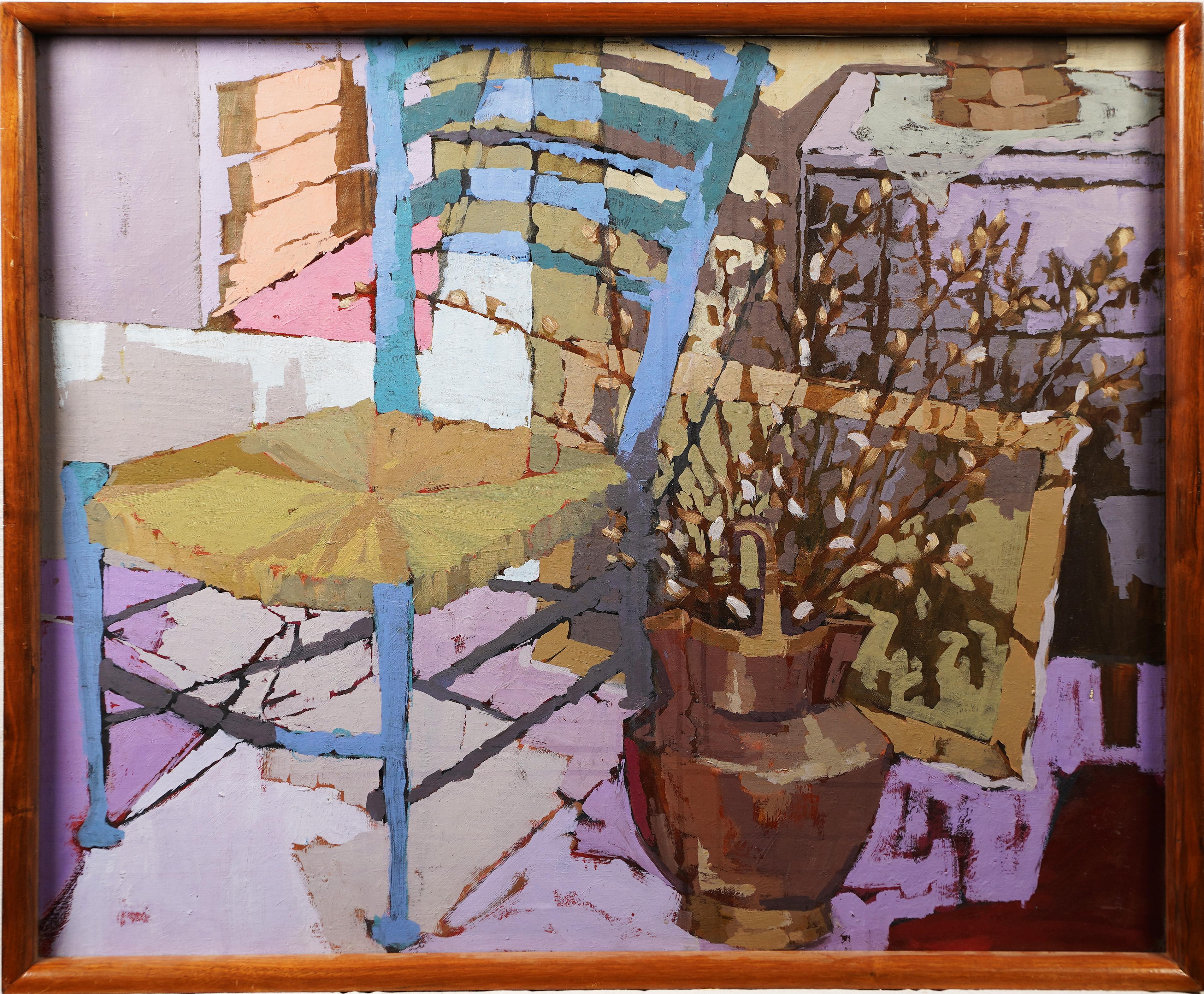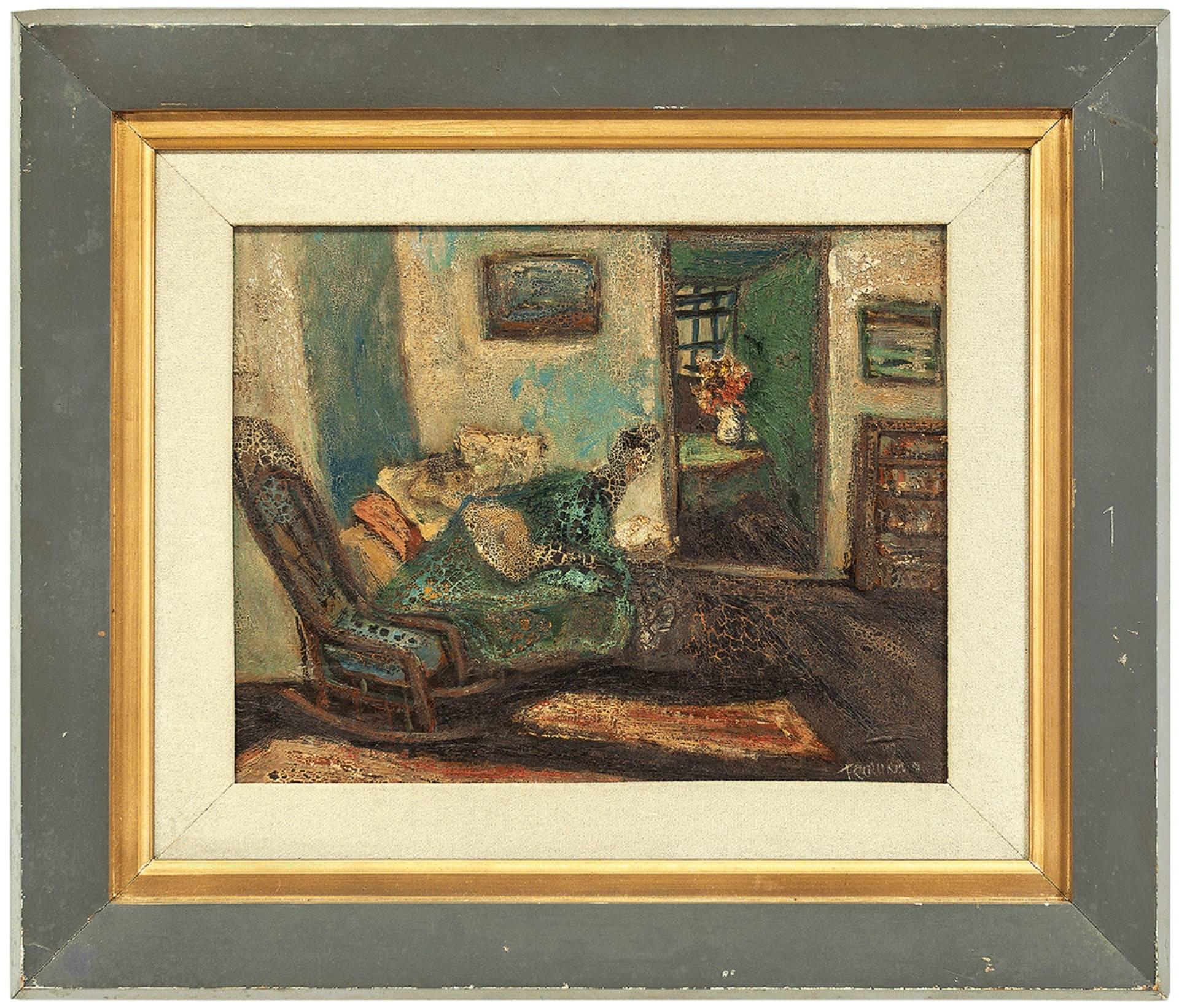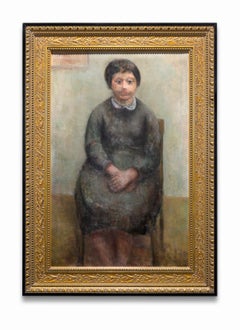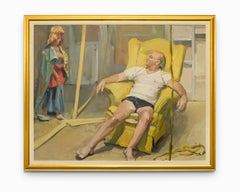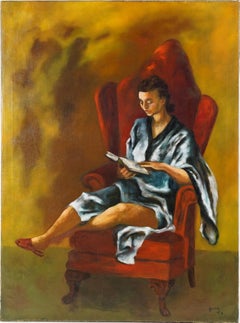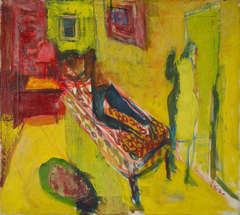Items Similar to Edgar Yeager Figurative Interior Scene
Want more images or videos?
Request additional images or videos from the seller
1 of 11
Edgar YaegerEdgar Yeager Figurative Interior Scene1982
1982
$3,900
£2,893.95
€3,371.06
CA$5,428.83
A$6,045.49
CHF 3,146.34
MX$74,540.16
NOK 40,071.09
SEK 37,662.94
DKK 25,152.27
Shipping
Retrieving quote...The 1stDibs Promise:
Authenticity Guarantee,
Money-Back Guarantee,
24-Hour Cancellation
About the Item
SALE ONE WEEK ONLY
Yaeger was an American Modernist painter from Detroit, Michigan, who is credited with being one of the first painters in this style. The portrait “Untitled” easily falls into this category with its large areas of complimentary colors, purples and orange, arranged in an abstract pattern surrounding the seated female.
Yaeger studied under Robert A. Herzberg at the Detroit School of Fine and Applied Arts, by which he was awarded the Founder's Society Purchase Prize. Subsequently, with the backing of the Anna Scripps Whitcomb Traveling Scholarship. He embarked on a study tour of eight European countries, from France to Czechoslovakia.
Yaeger was best known for his contributions to the Michigan Federal Art project and the Works Progress Administration scheme during the Depression Era, to which he contributed a number of murals that were displayed in public buildings. Some of his contributions are located at the West Quad Dormitory at the University of Michigan and the Detroit Public Lighting Commission Building.
His work in found in the collections of the Smithsonian Institution, Archives of American Art, the Detroit Institute of Arts, the Art Gallery of Windsor and the Kresge Foundation Collection in addition to numerous national personal collections.
Unframed the piece measures 14.19" h x 18.13" w.
- Creator:Edgar Yaeger (1904 - 1997)
- Creation Year:1982
- Dimensions:Height: 20.5 in (52.07 cm)Width: 24.5 in (62.23 cm)
- Medium:
- Movement & Style:
- Period:
- Condition:
- Gallery Location:Detroit, MI
- Reference Number:1stDibs: LU128618363172
About the Seller
5.0
Vetted Professional Seller
Every seller passes strict standards for authenticity and reliability
Established in 2014
1stDibs seller since 2019
108 sales on 1stDibs
Typical response time: 8 hours
- ShippingRetrieving quote...Shipping from: Detroit, MI
- Return Policy
Authenticity Guarantee
In the unlikely event there’s an issue with an item’s authenticity, contact us within 1 year for a full refund. DetailsMoney-Back Guarantee
If your item is not as described, is damaged in transit, or does not arrive, contact us within 7 days for a full refund. Details24-Hour Cancellation
You have a 24-hour grace period in which to reconsider your purchase, with no questions asked.Vetted Professional Sellers
Our world-class sellers must adhere to strict standards for service and quality, maintaining the integrity of our listings.Price-Match Guarantee
If you find that a seller listed the same item for a lower price elsewhere, we’ll match it.Trusted Global Delivery
Our best-in-class carrier network provides specialized shipping options worldwide, including custom delivery.More From This Seller
View AllCharles Pompilius figurative Young Female Nude Oil on Panel
Located in Detroit, MI
"Untitled" portrays a young female nude in an intimate setting within the artist's studio. This painting is done in the classical vein of full portraiture. The model, however, is not posed quietly, but is engaged with a person or object off the frame, or, perhaps in an interior monologue with herself. Regardless of which, the viewer's attention is not only attracted to the beauty of the model's figure, but the intention of her actions.
Charles Pompilius...
Category
Early 2000s American Modern Figurative Paintings
Materials
Oil, Panel
Marvin Cherney Portrait "Seated Girl" Oil on Canvas
By Marvin Cherney
Located in Detroit, MI
SALE ONE WEEK ONLY
"Seated Girl" is an oil on canvas portrait of an artist who was cut down in his prime and largely forgotten until recently. Marvin Cherney's paintings are solemn but unsophisticated in his subjects. He deploys a more limited range of greyed colors in order to emotionalize his subject and heighten the mood of their isolation. This painting was one of the thirteen that was exhibited at Garelick's Gallery in Detroit from January 8th through January 21st in 1961. The painting is 34.75 x 22.5 inches unframed.
Marvin Cherney was born in Baltimore, Maryland in 1925. He attended the Maryland Institute of Art and the School for Art Studies in New York. After his graduation he began to travel around Europe before returnig to New York.
Cherney won 2 Tiffany Awards and Brooklyn Museum Prize and his work has been exhibited at the National Academy of Design, The Art Institute of Chicago, Brooklyn Museum, Audubon Artists, University of Nebraska, Silvermine Artists Guild, Butler Art Institute, Ringling Museum, Howard University...
Category
1950s Portrait Paintings
Materials
Canvas, Oil
"Esther Before the King" Biblical Scene in Contemporary Setting, Drama, Colors
Located in Detroit, MI
SALE ONE WEEK ONLY
This captivating painting by an unknown artist takes the famous 17th century painting Esther before Ahasuerus by Artemisia Gentileschi and recontextualizes it for the modern era. In the original Old Testament story as depicted by Gentileschi, Esther, the Jewish wife of the king Ahasuerus went to him without being summoned after the king ordered the execution of all Jewish people in the Persian Empire. She asked him to spare her people, breaking court etiquette and risking almost certain death before fainting before the king. In this work we have the king of his house in his yellow recliner...
Category
Late 20th Century Contemporary Figurative Paintings
Materials
Canvas, Oil
Fred Cress Figurative Painting "Mirror, Mirror"
Located in Detroit, MI
SALE ONE WEEK ONLY
Complicated exchanges between individuals engaged in conversations, an argument, boredom, a caring exchange, toasting, so many human interactions within an almost five and a half foot square painting containing up to 25 people has been magnificently composed and is continuously captivating. The dynamism and flow of humanity in “Mirror, Mirror” can be compared to the dynamism and flow of humanity found in Breughel’s “Wedding Dance” owned by and located at the Detroit Institute of Arts.
Frederick Harold Cress was a British painter who migrated to Australia and won the Archibald Prize in 1988 with a portrait of John Bread.
Cress was born in Poona, British Raj, but went to England with his parents in 1948, when he was ten. He was educated at the Birmingham College of Art in England, and migrated to Australia in 1962 as a "ten pound Pom", meaning that he only had to pay ten pound for his fare to Australia. Cress met the painter Anne Judell and married her in 1967; they divorced in 1991. He started his career painting figuratively, but became well known for his abstract work in the late 60s and 70s. He returned to figurative painting in the late 80s after he won the Archibald Prize with a portrait of his friend and colleague, John Beard...
Category
Early 2000s Contemporary Figurative Paintings
Materials
Canvas, Acrylic
Fanny Rabel Figurative Oil Painting Soulful, Prayerful
By Fanny Rabel
Located in Detroit, MI
SALE ONE WEEK ONLY
UNTITLED by Fanny Rabel a Mexican artist who was born in Poland in 1922 is a soul wrenching work depicting among other things, the children killed by Nazi bombing in Spain during the Second World War. The lavender and purple surrounding the seated female figure and the kneeling child suggest both grief for the innocents' deaths and the prayers being offered for an end to the carnage. The bright gold and red can be read as either explosions or the hopeful light of redemption after death. Like Picasso's Guernica from 1937, this painting from 1965 can stand as a powerful anti-war statement.
Numerous key galleries and museums such as Morton Auctions, Cerro de Mayka have featured Fanny Rabel's work in the past. Her anti-Nazi and anti-Fascism politics resulted in her participation in a mural called Retrato de la Burguesía in 1940 for the Sindicato Mexicano de Electricistas building on Alfonso Caso Street in Mexico City. Rabel met a group of exiled Spaniards in Mexico along with Antonio Pujol, who invited her to take part in a mural project headed by him, David Alfaro Siqueiros, Joseph Renau, Luis Arenal, Antonio Rodríguez Luna and Miguel Prieto. The artist died in 2008.
Fanny Rabel born August 27, 1922, in Poland born Fanny Rabinovich, was a Polish-born Mexican artist who is considered to be the first modern female muralist and one of the youngest associated with the Mexican muralism of the early to the mid-20th century. She and her family arrived in Mexico in 1938 from Europe and she studied art at the Escuela Nacional de Pintura, Escultura y Grabado "La Esmeralda", where she met and became friends with Frida Kahlo. She became the only female member of “Los Fridos” a group of students under Kahlo’s tutelage. She also worked as an assistant and apprentice to Diego Rivera and David Alfaro Siqueiros, painting several murals of her own during her career. The most significant of these is "Ronda en el tiempo" at the Museo Nacional de Antropología in Mexico City. She also created canvases and other works, with children often featured in her work, and was one of the first of her generation to work with ecological themes in a series of works begun in 1979.
She is considered to be the first female muralist in Mexico. She was an assistant to Diego Rivera while he worked on the frescos for the National Palace and an apprentice to David Alfaro Siqueiros. Her most important mural is Ronda en el tiempo located in the Museo Nacional de Antropología, which was created from 1964 to 1965. She also created murals at the Unidad de Lavaderos Público de Tepalcatitlán (1945), Sobrevivencia, Alfabetización in Coyoacán in 1952 Sobrevivencia de un pueblo at the Centro Deportivo Israelita (1957) Hacia la salud for the Hospital Infantil de México (1982), La familia mexicana at the Registro Público de la Propiedad (1984) (which Rabel preferred to title Abolición de la propiedad privada) and at the Imprenta Artgraf. In collaboration with other artists, she participated in the creation of the murals at the La Rosita pulque bar (disappeared) and at the Casa de la Madre Soltera.
She entered the Escuela Nacional de Pintura, Escultura y Grabado "La Esmeralda" shortly after it was established in 1942, taking classes with José Chávez Morado, Feliciano Peña and Frida Kahlo, with whom she became close friends. She changed her last name from Rabinovich to Rabel during her career.
Rabel married urologist Jaime Woolrich and had two children Abel and Paloma Woolrich, both of whom became actors. The first exhibition of her work was in 1945 with twenty-four oils, thirteen drawings, and eight engravings at the Liga Popular Israelita with Frida Kahlo writing the presentation. In 1955, she had an individual exhibition at the Salón de la Plástica Mexicana. She had a large exhibition at the Museum of the Palacio de Bellas Artes to commemorate a half-century of her work. Her last exhibition was in 2007 at the Universidad Autónoma Metropolitana. Her work can be found in collections in over fifteen countries including those of the New York Public Library, the Library of Congress in Washington, D.C., the Royal Academy of Denmark, the National Library in Paris, the Casa de las Américas in Havana, the Benemérita Universidad Autónoma de Puebla and the Museo de Arte Moderno in Mexico City.
A retrospective of her work after her death called Retrospectiva in Memoriam, Fanny Rabel (1922-2008) was held at the Museum of the Universidad Popular Autónoma del Estado de Puebla . She is considered to be the first modern female muralist in Mexico although she also did significant work in painting, engraving, drawing, and ceramic sculpture. Her work has been classified as poetic Surrealism, Neo-expressionism and is also considered part of the Escuela Mexicana de Pintura (the dominant art movement of the early to mid 20th century in Mexico) as one of the youngest muralists to be associated with it along with Arnold Belkin and José Hernández Delga.
Rabel was more drawn to depicting mankind’s pain rather than happiness, sharing other Mexican muralists' concerns about social injustice. However, she stated to Leopoldo Méndez that she could not create combative works, with clenched fists and fierce faces, and she wanted to leave the Taller de Gráfica Popular. Méndez convinced her to stay, saying that more tender images are important to political struggle as well. Children with Mexican faces...
Category
1960s Expressionist Figurative Paintings
Materials
Oil, Canvas
Fantastic Rafael Coronel Mixed Media 1961
By Rafael Coronel
Located in Detroit, MI
"Untitled" is a dramatically placed individual who appears to be withdrawing into herself surrounded by a soft pinkish color. She has a sad look in her non-reflective eyes. This pain...
Category
Mid-20th Century Futurist Portrait Paintings
Materials
Mixed Media, Board, ABS
You May Also Like
Vintage Large Signed American Modernist Interior Scene Portrait Oil Painting
By Sidney Gross
Located in Buffalo, NY
Antique American modernist signed portrait oil painting by Sidney Gross (1921 - 1969). Oil on canvas. Signed.
Category
1930s Modern Interior Paintings
Materials
Canvas, Oil
$1,196 Sale Price
20% Off
Interior with Figures
By Arthur Osver
Located in Dallas, TX
Arthur Osver studied at Northwestern University and the Art Institute of Chicago. Osver was awarded the Prix de Rome in 1952. He taught at the Brooklyn Museum Art School, Columbia Un...
Category
1930s American Modern Interior Paintings
Materials
Canvas, Oil
Vintage American Modernist Abstract Interior Scene Framed Oil Painting
Located in Buffalo, NY
Antique American modernist interior scene oil painting. Oil on canvas. Framed.
Category
1940s Modern Abstract Paintings
Materials
Canvas, Oil
$1,196 Sale Price
20% Off
Abstract Interior Scene
By Abram Tromka
Located in Surfside, FL
Measures 16.5 X 20 without frame. heavy craquelure. it seems like some sort of experimental technique the artist used. paint is stable. please see photos Abram Tromka was born May 1, 1896 in Poland. At the age of seven he immigrated with his family to the United States, settling in New York City. It was on the boat coming to New York where Tromka first became interested in art. Fascinated by a woman who was painting, he decided that he wanted to become an artist. Upon arrival at immigration headquarters, Tromka’s family adopted the surname “Phillips,” which he kept until 1930. Hence the artist’s early works bear the signature — ‘A. Phillips.’
Having a rough childhood, Tromka left home at 15 and spent the remainder of his teenage years living at the Henry Street...
Category
20th Century Modern Abstract Paintings
Materials
Oil, Board
Interior with portrait
Located in Paris, IDF
Léon Louis PARENT
(Armentières, 1869 – Aulnay-sous-Bois, 1943)
Interior with portrait
Oil on canvas
Signed and dated lower right
35 x 27 cm without frame
45 x 38 cm with frame
1911...
Category
Early 20th Century French School Still-life Paintings
Materials
Oil
Mid-Century Modern Vintage Original Interior Oil Painting - Vibrant Interior
Located in Bristol, GB
VIBRANT INTERIOR
Size: 54.5 x 70.5 cm (including frame)
Oil on canvas
A lively mid-century interior scene painting that captures a vividly colourful and expressive depiction of a d...
Category
Mid-20th Century Expressionist Interior Paintings
Materials
Oil, Canvas


